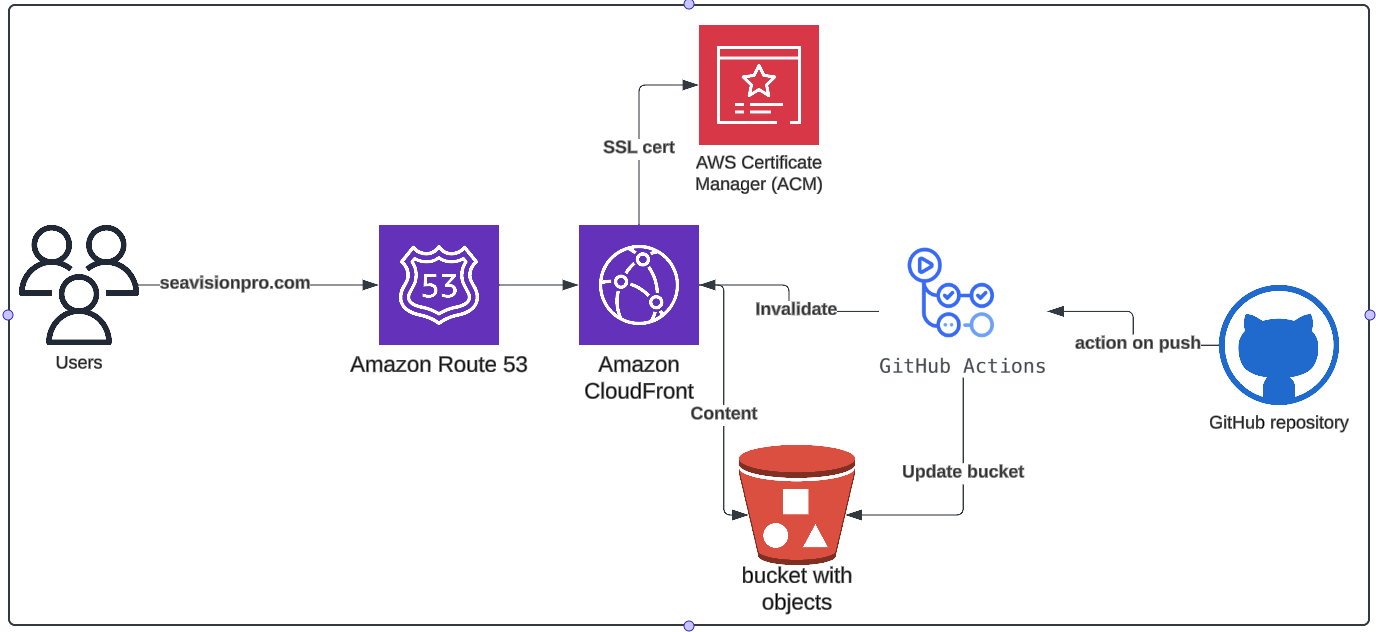SeaVisionPro - Deep Dive
Dive into the technical journey of creating SeaVisionPro.
Designed to provide accurate underwater visibility predictions for diving and snorkeling enthusiasts.
From infrastructure setup to algorithm development, this post walks through the challenges, decisions, and final architecture of the platform.

The Inspiration Behind SeaVisionPro
I love the sea, and I’ve always been fascinated by the underwater world.
Living a bit farther from the beach, I couldn`t simply check visibility when I woke up, planning a snorkeling trip required foresight.
This sparked my curiosity, and I began researching how weather metrics influence underwater visibility.
I crafted an algorithm to analyze these metrics and ran it on aws lambda which emailed me using SQS and SNS the night before, letting me know if the next day would be ideal for snorkeling.
For a year, I used this simple system to plan early morning trips, giving me plenty of time to prepare my gear and get to the beach.
The experience was so helpful and exciting that I realized it could benefit others, leading to the creation of SeaVisionPro — A platform to share this convenience and joy with the wider diving and snorkeling community.

Website Infrastructure Setup
Focused on AWS services stack, I wanted a simple, resilient, cost-effective setup to host and serve the frontend section of SeaVisionPro.
-
AWS S3 and CloudFront:
The site is hosted on AWS S3 as a static website, with CloudFront handling CDN and caching to ensure fast load times worldwide.
SSL/TLS encryption was implemented using AWS ACM for secure browsing. -
Domain and Routing:
The custom domain, seavisionpro.com, is managed via AWS Route 53, which ensures reliable and efficient DNS resolution.
Setting up a CNAME record for the certificate and an A record to connect the cloudfront distribution. -
Deployment Pipeline Full CI/CD:
Make dev easier with a CI/CD process.
A custom GitHub Action automates deployments by pushing updated files to S3 and invalidating the CloudFront cache. This streamlines development and ensures the latest content is always available to users. -
Frontend Design:
Haven't met a Backend developer who loves Front end dev yet, and Im no different in that aspect.
I looked for tools that made this process easier. Built using Relume, Figma and Webflow to generate ths sitemap, design and color scheme and export the HTML, CSS, and JS.
This tools incorporate AI to help with design and responsiveness. The design balances user-friendliness with responsiveness, providing a seamless experience across devices.

Backend Algorithm Infrastructure
I needed a scheduled process that would fetch weather metrics, run a custom algorithm to determine tomorrow's visibility rating and somewhere to store the results.
-
Data Collection and Processing:
The backend algorithm collects weather metrics data on wave height, water temperature, and other parameters using AWS Lambda functions triggered by EventBridge event.
This ensures automated updates every evening, also, the lambda free tier is not breached, so no additional costs.
Running a Java lambda, the project had to be light with minimal start time.
That means no heavy libraries, no spring, no hibernate, just plain java and the algorithm has to be very efficient. -
Data Storage:
Processed data is stored in an AWS DynamoDB table.
I selected DynamoDB since there are no ongoing storage costs (within free tier) and since its nosql, I can use it for other projects that would require different items stored.
Also, DynamoDB and ApiGateway integrate well, and I can fetch data directly from the table without any additional services. -
API Layer:
I use API Gateway to expose an endpoint that fetch visibility data and provide predictions.
This endpoint fetches data directly from DynamoDB, without Lambda or other services, insuring low latency and low cost. -
Prediction Algorithm:
A custom algorithm I crafted, analyzes recent weather data to generate visibility rating predictions.
The logic is optimized to deliver reliable predictions based on historical, predicted metrics and real-time trends.
The algorithm asses the data by assigning a "weight" to each metric, and then summing the weights to get a final score.
-
Deployment Pipeline Full CI/CD:
I put together a custom GitHub Action automates deployments by running UTs, packaging and updating the lambda with the jar. This streamlines development and makes my life allot easier.

Final Thoughts
As this is a "niche" site, I'm not expecting more than a few thousand entries per month, however,
The infrastructure is designed to handle variable traffic volumes efficiently,scale dynamically while maintaining high availability and with minimal ongoing maintenance costs.
SeaVisionPro is my first full website in production, it successfully delivers daily visibility predictions for multiple regions, helping divers and snorkelers plan their activities.
Future updates aim to include more content, additional regions, and improved prediction algorithm.
Don't forget to check out SeaVisionPro.com
Related Projects and Blog Posts




